2
Achievements of the Biological Threat Reduction Program
During the past 15 years, the Biological Threat Reduction Program (BTRP) of the Department of Defense (DOD) has carried out activities in Russia, Kazakhstan, Uzbekistan, Georgia, Azerbaijan, and Ukraine. The activities have involved a number of ministries and several dozen institutions in the countries. The cost to the U.S. government has been more than $430 million from Fiscal Year (FY) 1998 through FY 2007, with expenditures in earlier years very limited. Figure 2-1 illustrates the trend in BTRP funding in recent years.
FIGURE 2-1 BTRP funding in recent years (in millions of U.S. dollars).
SOURCE: Data provided by DTRA, June 6, 2007.
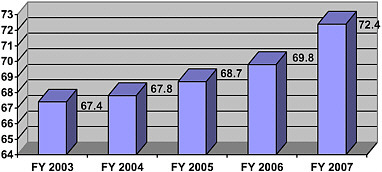
The distribution of funding by country is shown in Figure 2-2.
FIGURE 2-2 BTRP funding by country, FY 1998-2007 (in millions of U.S. dollars).
SOURCE: Data provided by DTRA, April 2007.
NOTE: Additional program administration costs of $81.9 million that have affected programs in all countries are not included in this figure.
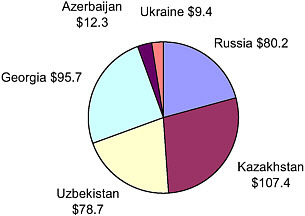
BTRP and its predecessor programs have addressed key aspects of the overall U.S. effort to prevent the proliferation of biological weapons. The categories of activities are as follows:
-
Biological Infrastructure Elimination, with three facility dismantlement projects completed in Kazakhstan and Georgia and on Vozrozhdeniye Island in the Aral Sea
-
Biosafety/Biosecurity, which involves facility upgrades, training, and related activities throughout the region and initial steps in establishing the Threat Agent Detection and Response (TADR) network in Georgia, Azerbaijan, Uzbekistan, and Kazakhstan
-
Cooperative Biological Research, with research laboratory upgrades and research projects carried out in Russia, Kazakhstan, Uzbekistan, Georgia, and Azerbaijan
-
Program Administration, involving supporting activities by a variety of organizations, including a contractor-led Threat Reduction Support Center that supports a staff of more than 30 analysts and advisers for BTRP and contracts to cover costs of shipments of materials and equipment that must be handled carefully, undertakings that consume more than one-half of the funds available for this program element.
The distribution of expenditures among these four program categories is set forth in Figure 2-3.
FIGURE 2-3 BTRP funding by program category, FY 1998-2007 (in millions of U.S. dollars).
SOURCE: Data provided by DTRA, April 2007.
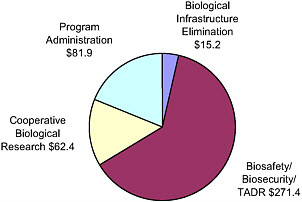
The committee has not analyzed in detail the financial aspects of BTRP. However, several concerns about levels of expenditures are expressed later in this report. At the same time, the committee is aware of the political, administrative, and logistics difficulties in carrying out programs in the former Soviet Union. It recognizes the need for substantial resources to mount effective programs. In any event, the Government Accountability Office (GAO) has informed the committee that it will again examine BTRP beginning in late 2007, and GAO’s financial expertise should be helpful in identifying ways to improve program efficiency.
Positive Impacts of BTRP
During the past decade, committee members have observed first hand in the former Soviet Union (FSU) a wide variety of BTRP activities. Many activities have facilitated professional ties among important specialists in the region and the United States and have enhanced the containment of biological materials, technologies, equipment, and expertise that, if misused, could result in serious biological threats. From these observations, it is clear that there have been important changes in the region that can be attributed at least in part to BTRP. The changes include
-
Unprecedented transparency at dozens of important facilities with dual-use capabilities that had not previously been open to foreign specialists
-
Dismantlement and/or conversion of three production facilities and dozens of research institutes that supported biological weapons activities
-
Redirection to civilian pursuits of hundreds of senior biological scientists, engineers, and technicians who were formerly engaged in defense programs
-
Attraction and retention of hundreds of younger specialists working in basic sciences and in the fields of public health and agriculture
-
Adoption by local institutions of American-style approaches to project management and to fiscal accountability
-
Participation in dozens of scientific conferences and training programs abroad by specialists from the region who had not previously traveled abroad
-
Increased publication by local scientists in peer-reviewed international journals of their research findings, which demonstrate their capabilities to participate effectively in international scientific activities
-
Enhanced quality of a number of local research projects and technology transfer activities that have taken advantage of the experience and expertise of international collaborators
-
Improved biosecurity and biosafety at biological research institutions, particularly with regard to consolidation and physical protection of dangerous pathogen strains
-
Opening and sharing of local databases with international collaborators
-
Construction and equipping of modern research, public health, and agriculture facilities where activities of interest to international partners are carried out
-
Development of local regulations and related training programs concerning the safety and security of biological materials and good laboratory practices in six countries.
BTRP engagement activities have led to many international linkages based on friendships and common professional interests. These personal contacts are important in building mutual respect and trust that are necessary for successfully addressing technical issues with dual-use implications. They also provide insights as to present and future scientific aspirations and intentions of foreign colleagues and their institutions in areas of national security importance.
In addition, intergovernmental cooperation in the biological sciences and biotechnology, exemplified by BTRP, offers opportunities for political and scientific leaders from the United States and partner countries to discuss common security and health interests. Such discussions can lead to the development of complementary approaches for combating threats of global terrorism. For example, the discussions of transnational diseases and potential bioterrorism problems during the G-8 Summit in St. Petersburg, Russia, in 2006 were undoubtedly enriched by the extensive interactions between U.S. and Russian specialists through BTRP and related programs over many years.
The participants from the region in BTRP activities seem very pleased with the support they have received (see, for example, Box 2-1). They are particularly enthusiastic about their upgraded laboratories and related facilities, with (1) improved research conditions for both well-established scientists and young scientists, (2) new opportunities to participate in activities of interest to the international scientific community, and (3) better control of biological materials. Meanwhile, some are disappointed that they have not received longer term support, particularly in Russia.
|
BOX 2-1 Observations on BTRP by Foreign Colleagues
SOURCE: Comments obtained by project staff, consultants, and committee members, April 2007. |
In short, past BTRP investments have provided substantial benefits for national security. Also, they have set the stage for continuing access to important biological expertise in the former Soviet Union. The task of preventing proliferation has only begun, and the opportunities for future contributions by BTRP to national security are many fold. Therefore, the U.S. government should provide strong and sustained support for BTRP and related programs.
In the first instance, the Department of Defense (DOD) must be a strong advocate for BTRP. Such advocacy currently seems to be the case, given future budget projections that have been approved within DOD and forwarded to the Congress as will be discussed in Chapter 5. The White House, and particularly the Office of Management and Budget and the National Security Council, should give continuing support and encouragement to BTRP. Also, Congress needs to continue its recognition of the importance of BTRP.
This is not to say that BTRP should continue its current course without adjustments. The program was developed at a time of unprecedented economic deprivation in the region and in the wake of the Soviet era. Indeed, in many ways the next phase of BTRP activities should be significantly different from the early start-up phase. Throughout this report, suggestions are offered on modifications that could enhance the positive impacts of BTRP on the national security interests of the United States and partner nations as BTRP adapts to the changing environment in the years ahead.
Biological Weapons Infrastructure Elimination
The expenditures to date for this program component have been allocated as shown in Figure 2-4.
FIGURE 2-4 Funding of biological weapons infrastructure elimination by country, FY 1998-2007 (in millions of U.S. dollars).
SOURCE: Data provided by DTRA, April 2007.
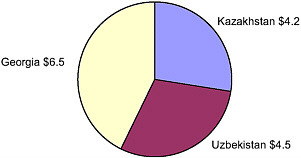
Activities have included dismantlement of the anthrax production facility at Stepnogorsk in Kazakhstan; destruction of 150 tons of anthrax weapons agent buried in pits adjacent to the open air testing facility on Vozrozhdeniye Island, which is surrounded by the Aral Sea; and destruction of dual-use facilities capable of producing viral animal pathogens at Biokombinat in Georgia. These efforts should be completed during FY 2008. No additional activities are currently planned.
The importance of destroying industrial capabilities that were designed to produce and test ingredients for biological weapons seems obvious. The political and technical aspects of dismantling these facilities have been complicated. Nevertheless, despite lengthy delays and high costs, BTRP activities are being carried to completion in cooperation with local specialists.
BTRP did not conduct infrastructure elimination activities at other production facilities such as those located in Omutninsk, Berdsk, and Pokrov in Russia. At each of these facilities, steps have been taken by the Russian government, either directly or through support of privatization efforts, to change the facility’s profile to peaceful uses. The Department of State has been an active partner in some of these developments. Other production or test facilities of importance may be located at Russian military facilities, but international access to such facilities seems unlikely. In short, the committee is unaware of other production, storage, or testing facilities in the former Soviet Union where BTRP should focus future infrastructure elimination activities.
Biosafety/Biosecurity and Threat Agent Detection and Response (TADR)
The funds allocated for this program activity through FY 2007 are shown in Figure 2-5.
FIGURE 2-5 Funds allocated for biosafety/biosecurity and TADR by country (in millions of U.S. dollars).
SOURCE: Data provided by DTRA, April 2007.

This budget category is by far the largest. It includes the widest diversity of activities. DOD describes the activity as follows:
This project consolidates and secures especially dangerous pathogen (EDP) collections in safe, centralized facilities to prevent terrorist acquisition of BW seed materials; improves biosafety and biosecurity; enhances recipients’ abilities to detect, diagnose, and respond to disease outbreaks; and ensures safe, secure storage handling of EDPs used for beneficial research against accidental release, theft, and exposure. DOD and recipient states are developing a network of disease surveillance and diagnostics laboratories at the national, state, and county level (referred to as the Threat Agent Detection and Response [TADR] network) that are linked with an Electronic Integrated Disease Surveillance System to facilitate rapid reporting of outbreak data to national authorities and U.S. government counterparts. Another electronic database called the Pathogen Asset Control System will inventory, store, and control access to select agents. Eventually, countries’ networks will link with regional partners to enhance disease monitoring, reports, and containment, and ensure early warning of potential bioattacks and pandemics. DOD created training modules to improve diagnostic and epidemiological capabilities of the scientific and technical staff; promote bioethics, biosafety, and biosecurity; and ensure sustainment, effectiveness, program investment, and strategic relevance.
In non-Russian states, BTRP develops national Central Reference Laboratories (CRLs) with state-of-the art diagnostics capabilities on an information technology backbone, and modern communications. These laboratories provide Mobile Outbreak Response Units with diagnostics
and epidemiological teams for rapid response to potential incidents and with veterinarians and clinicians who conduct population-based surveillance in areas where EDP cases may occur. The regional-level Epidemiological Monitoring Stations survey suspicious disease outbreaks, analyze epidemics, and collect disease reports from veterinarians, clinicians, or epidemiologists.
Lacking a BTRP implementing agreement with Russia, BTRP provides only safety and security upgrades at selected former BW facilities still working with dangerous pathogens.1
At present, BTRP is finishing security upgrades and biosafety programs in Russia at institutes in Golitsino, Pokrov, Vladimir, Koltsovo (Vector), Obolensk, and Kazan. In the other former Soviet states, construction and renovation to improve security at a variety of facilities are under way. Most of the activity in these non-Russian states relates to the establishment of the TADR system, such as upgrading epidemiological monitoring stations, consolidating strains in central repositories, and training in epidemiology, diagnostics, biosecurity, and information technology. While BTRP is emphasizing within TADR laboratory diagnostic, surveillance, and reporting capacity, relatively little attention is being given to strengthening the human dimension of epidemiology systems—particularly the field dimension.
Committee members have observed BTRP-supported security upgrades at a number of facilities. In each case, the physical upgrades were needed, and the resulting security arrangements are impressive. Given the large number of facilities where pathogens are located, the need for additional upgrades seems clear. BTRP, in cooperation with partner governments, should continue to carry out detailed analyses of additional facilities as the basis for targeting future security-oriented upgrades.
Security is more than physical protection of biological assets. It requires a strong culture among the staffs of the facilities concerning proper handling of sensitive materials and appropriate use of dual-use equipment. Unfortunately, BTRP’s commercial integrating contractors do not always appreciate the long Soviet history of security measures in the region and the attendant commitment of personnel to protect virulent strains. They sometimes do not recognize the positive aspects of this history in their zeal to establish made-in-America security systems according to compressed timetables. While prompt installation of modern approaches is important, BTRP should build on past practices and should not develop systems that cast aside valuable experience of counterparts. Also, American experts employed by BTRP as trainers should not offer counterparts overly simplistic courses in biosecurity and biosafety, a practice that committee members have observed.
Protection of a wide variety of strains of dangerous pathogens is a particularly important issue. BTRP’s current approach is to assume that all strains of certain pathogens must be housed in appropriately equipped centralized facilities without segregation of pathogen strains according to virulence. Strain collections reflect endemic diseases, and live cultures need to be maintained locally for use in diagnostics and research. However, retention of strains at smaller laboratories and at field stations requires diagnostics equipment and reliable supplies of reagents and consumable supplies together with appropriately trained staff. BTRP should enroll experienced researchers as well as biosafety experts to assist in developing plans for handling and protecting strains
both in centralized facilities and in local facilities where they are readily available for researchers.
Turning to the TADR network, it was designed by BTRP with only limited consultations in the region. Since that time, BTRP has been attempting to convince partner governments to participate in the network. BTRP has had considerable success, at least as long as BTRP is to provide financial resources. As advocated in Box 2-2, BTRP should give greater emphasis to local “needs assessments” as the basis for TADR investments, which would include consideration of endemic diseases that are not linked to especially dangerous pathogens.
|
BOX 2-2 Importance of Needs Assessment “In public health, an initial ‘needs assessment’ in a target population is critically important. It gives an estimate of the burden of disease or need, it describes gaps in services or responses, it provides a basis for setting priorities for interventions, it provides a baseline for estimates of program progress or success, and it begins the process of partnership and local ownership and helps build sustainability by breaking down barriers among disciplines and among local government agencies.” American health policy analyst commenting on the importance of country-specific needs assessments as important missing components of the TADR program, July 2007. |
In 2006, the National Research Council carried out a review of the plans for and early stages in development of the TADR network, with particular emphasis on the electronic data system and the General Data Repository that is to be located in the United States. This review concluded that the TADR network is an important initiative that has the potential to enhance U.S. security interests in a variety of ways. The recommendations of the review are set forth in Appendix B. The continued progress in developing the network since the completion of the review is welcomed. However, several important recommendations that emerged from the review deserve special attention, namely,
-
Sustainability of the TADR network after BTRP completes its participation in the development and operation of the network is critical. An assessment that sets out on a country-by-country basis the near-term benefits from the network for those local officials and specialists responsible for disease control is clearly needed. The assessment should address the likely sources of funding for TADR, from national and international sources, after BTRP support terminates. Not only are activities directly related to dangerous pathogens of interest, but also integration of new capabilities with existing programs to address day-to-day public health challenges is particularly important. The assessment should be prepared by the partner governments in cooperation with BTRP as soon as possible.
-
A related element of sustainability of the TADR network is the broadening of the focus of the network from the limited number of disease agents, classes of agents, and
-
syndromes of primary interest to DOD for proliferation reasons. A wider focus that encompasses high incidence agents and diseases that are of great human and animal health significance to the host governments is essential. Such an approach should increase the interest of local and national officials in information that is obtained and should encourage them to embrace the system as an important component of their national efforts. A good example of BTRP flexibility is the current BTRP effort to address an outbreak of swine flu in Georgia, and this type of flexibility should become routine within BTRP.
-
Automatic transmission through the TADR network of all data that are collected by physicians, laboratory specialists, and other participants in the program will surely result in many false alarms due to abnormalities in trends and outbreaks. BTRP should establish mechanisms for limiting the data that are entered into the system to information that appears to be significant. BTRP should work with partner governments to ensure that such filtering of data in the partner countries is done in an appropriate, timely, and responsible manner. The committee questions the DOD viewpoint that the advantages of the fully automated data exchange features of the system outweigh the difficulties posed by false alarms generated by the unfiltered data. DOD apparently is not concerned about false alarms since American specialists at the Centers for Disease Control and Prevention presumably will be available to identify them. However, in the long run, local institutions will have the responsibility for assessing the evidence of possible false alarms, as well as leading any response efforts, and they should accept these responsibilities from the outset.
The strong training aspect of the biosecurity and TADR components of BTRP is commendable. In Soviet times, most training courses for specialists were held in Russia and to a lesser extent in Kazakhstan. When the USSR splintered into 15 states, many specialists from Central Asia and the Caucasus region lost their training opportunities. Thus, partner institutions are enthusiastic over BTRP training efforts. Also, they welcome opportunities to establish training centers in their own countries. It is particularly important that BTRP, in cooperation with counterpart institutions, ensure that preparations for adequate personnel to work in new and renovated facilities keep pace with construction schedules. If modern and well-equipped laboratories are not fully utilized by trained personnel, the program could lose much of its credibility.
Cooperative Biological Research
This component of the program has distributed funds to date as shown in Figure 2-6.
FIGURE 2-6 Funding for cooperative biological research, FY 1998-2007 (in millions of U.S. dollars).
SOURCE: Data provided by DTRA, April 2007.
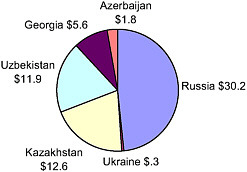
Figure 2-7 illustrates the breakdown of expenditures between U.S. and FSU partners.
FIGURE 2-7 Recipients of CBR Program funds, FY 1998-2007 (rounded to nearest $.1 million).
SOURCE: Data provided by DTRA, April 2007.

Tables 2-1 and 2-2 provide more detailed cost itemizations on the U.S. and FSU sides, respectively.2
|
2 |
Data for Figure 2-6 and Tables 2-1 and 2-2 provided by DTRA to National Academies staff in May 2007. |
TABLE 2-1 U.S. cost distribution, FY 1998-2007.
|
Contractor management and fees |
$11,473,000 |
|
Concept/proposal development |
$6,429,000 |
|
U.S. collaborators/visiting scientists/training |
$11,363,000 |
|
DoD collaborators |
$2,603,000 |
|
Logistical support |
$1,220,000 |
|
Advisory and assistance services |
$4,544,000 |
|
Conferences, training, and workshops |
$1,728,000 |
|
Government (travel, fees, shipping) |
$7,226,000 |
TABLE 2-2 FSU cost distribution, FY 1998-2007.
|
Institute overhead |
$ 464,000 |
|
Grant payments |
$9,025,000 |
|
Equipment and materials |
$7,258,000 |
|
Travel (conferences, workshops, training) |
$ 738,000 |
|
Other direct costs |
$1,493,000 |
|
Renovations |
$547,000 |
Figure 2-7 shows that almost 75 percent of funds available for CBR are provided to U.S. organizations. This large percentage does not encourage international enthusiasm for the program and needs to be reduced, particularly as the program grows. As noted in Box 2-3, high levels of funding of U.S. institutions should soon begin to decline, at least in the countries where BTRP has been engaged for a number of years and facilities are in improved condition.
|
BOX 2-3 Upgrading Institutes “We are not just dropping projects into well-equipped institutes that have staffs that are trained in modern techniques, that have biosafety programs up to U.S. standards, and that have animal-use protocols that would pass in the United States. We have to start with none of these and set them all up. This is an engagement program that supports institutes that have struggled through years of very poor funding. Their infrastructure is in terrible shape, and we try to modernize it. A large portion of the costs on the U.S. side are ensuring that such modernization takes place—training people correctly and designing facilities to meet U.S. standards. When the institutes are up to U.S. standards, the costs to the U.S. side will drop significantly.” U.S. scientific adviser to BTRP, May 2007. |
A list of the research projects that have received support is set forth in Appendix F. In addition to funding these research projects, a number of investments have been
made in upgrading research facilities. Only some of the renovation costs are reflected in Table 2-2, since the biosecurity and biosafety programs also at times support renovations in areas where research is carried out.
Initially, BTRP involved a number of Russian institutions and scientists that had been directly involved in biological weapons development. Immediate redirection to civilian topics of key weapon scientists took priority over the scientific importance of their research topics. Quickly the focus of BTRP narrowed to a concentration on extremely dangerous pathogens with greater emphasis on the importance and scientific quality of the research projects.
As support for research activities moved from Russia to the other countries, the emphasis shifted to research that supported the TADR network, particularly with regard to enhancing epidemiological and diagnostics capabilities. Also, BTRP became increasingly concerned about promoting standards of openness, research ethics, and international health partnerships that can be helpful in countering bioterrorism threats.
This activity has been driven largely by the interests of BTRP, although partner governments are now having greater input as to which types of research are the most important. However, American specialists are more familiar with research opportunities within BTRP’s mandate and therefore quickly persuade counterparts to accept BTRP’s priority topics. While scientists in the region are responsible for preparing proposals, the opportunities for stretching beyond the specific topics of interest to BTRP have been limited. Nevertheless, high quality research, measured against international standards, has been carried out, particularly in Russia.
This component of BTRP has opened a number of doors into sensitive areas of biological activities. Researchers who played key roles in the Soviet biological weapons program have been participants in BTRP, particularly in Russia. The skills of a number of researchers have been widely acclaimed by American counterparts.
However, DOD has apparently been concerned for a number of years that the Russian government would misuse the results of BTRP-supported research projects concerning dangerous pathogens, although the committee is unaware of any indications of such misuse. DOD has repeatedly introduced delays into the program in Russia due to a lack of confidence in Russia’s reliability as a responsible partner in dealing with dangerous pathogens, and the program is now limited to research related to smallpox. DOD has shown little interest in future security or scientific payoffs from engagement in other activities in Russia in its decision to sharply reduce activities in Russia (see, for example, Box 2-4). Meanwhile, Russian authorities are suspicious of DOD’s motivations in the biological area. The issues surrounding the future of the program in Russia will be discussed in Chapters 4 and 5.
|
BOX 2-4 Capitalizing on Past Investments “Russian scientists are gravely concerned about reduction of BTRP research funding, particularly after initial investments in training in modern project management methods as well as provision of equipment that would enable both Russia and the United States to benefit much more from future projects.” Senior Russian scientist, March 2007. |
Turning to the other former Soviet states, a limited number of research projects have been supported. Almost all can be characterized as applied research. As the investigators have greater access to modern equipment and are able to stay abreast of international research activities, basic research may play a more significant role in the program. But it seems appropriate for BTRP now to stress research that can lead to relatively near-term applications.
Activities of Special Concern
Within the foregoing program elements, several topics deserve special attention.
-
BTRP has taken the excellent initiative to develop country science plans that are to provide a programmatic framework in each country for BTRP activities. However, this approach needs more active involvement by partner governments. The plans should clearly reflect local priorities. Of course, they should be consistent with overall U.S. government country approaches and take into account programs supported by other external parties. The BTRP plans should include not only descriptions of BTRP activities but also BTRP exit strategies that will help ensure that activities are sustained over the long term. Emphasis should be given to the engagement of leading scientists and promising young researchers of the partner countries in BTRP activities and the likelihood of attracting the interest of strong American collaborators.
-
BTRP is establishing a Central Reference Laboratory (CRL) in Georgia at a cost of $60 million, with annual operating costs estimated at more than $5 million. A large portion of the cost is due to inclusion within the facility of a Biosafety Level 3 (BSL-3) laboratory. The committee is concerned about the sustainability of the CRL, and particularly the BSL-3 laboratory, over the long term. Joint strategic planning for this and other CRLs should ensure that the anticipated long-term health and agriculture benefits, particularly the benefits derived from expensive BSL 3 capabilities, warrant both the initial and life-cycle costs (see also Chapter 5).
-
An early evaluation of the health and agriculture benefits of the TADR network that is being established initially in Georgia is needed. The key question is whether the information obtained through the TADR network is a significant improvement over data collected through traditional methods and is useful in improving human health. This evaluation will help ensure that similar BTRP investments in other countries are well targeted and result in discernible benefits that encourage future local investments.
-
Returning to the issue of pathogen strain collections, joint programs should ensure that strains that can be obtained within the region are available at local facilities to international investigators. Investigating the characteristics of strains that are unique to specific regions has special importance in understanding actual and potential disease burdens, possibilities for transborder transmissions of diseases, and development of natural immunities. Of course, the facilities must have appropriate biosafety environments. Opportunities to examine strains in the region will reduce the need for controversial transfers of such strains to the United States that raise questions over BTRP objectives and unnecessarily delay projects. Inclusion of sequencing data from these
-
investigations in GenBank and noteworthy findings in international journals would be significant scientific contributions. DOD has included one-way strain exchanges as a requirement in its intergovernmental agreements and has been successful in receiving strains from Georgia and Azerbaijan. However, future one-way exchanges are not assured, especially from other countries in the region, and the partner governments should be given the option of joint investigations locally as an acceptable alternative to strain exchanges.
Moving Forward
BTRP achievements provide a strong base of experience and of demonstrated success that can enable the U.S. government to continue to make important contributions to preventing the proliferation of biological weapons. Of particular importance has been BTRP’s adoption of a broadly based approach to protecting the public from both naturally occurring and deliberately induced diseases (see Box 2-5).
|
BOX 2-5 Integrating Diverse Biological Interests “Integration of specialists from the health care sector and veterinary services, researchers and practitioners, and representatives of the basic and applied sciences within the framework of joint projects makes it possible to hope for additional scientific and practical results through the synergetic interaction of specialists united by a common goal—reducing the threat of biological pathogens and making the population safer.” Director of Kazakhstani research institute, March 2007. |
BTRP, in coordination with the Department of State, was the first U.S. biological nonproliferation program on the ground at many facilities in Russia and other former Soviet states. Thus, it is not surprising that BTRP developed an array of technical capabilities that largely fall within the province of other departments, such as the Department of Health and Human Services (DHHS) and the Department of Agriculture (USDA). As the other departments became involved through different Congressional mandates, the need for coordination of efforts and avoidance of duplication was clear, as will be discussed in Chapter 3. Now, as the budget of BTRP continues to grow while the nonproliferation budgets of the other departments decline, BTRP has an increased responsibility to draw on the best U.S. capabilities present in the other departments in support of BTRP’s expanding interests in public health and agriculture. Indeed, the BTRP budget during FY 2008 will probably be much larger than the budgets for DHHS and for USDA, and BTRP will have to make aggressive financial outreach efforts to encourage DHHS and USDA to continue their interests in nonproliferation. To this end, the authorizing legislation for BTRP should explicitly call on BTRP to utilize the assets and expertise of these departments to the fullest extent that is practical and to provide financial support to the other departments for facilitating joint activities.
















